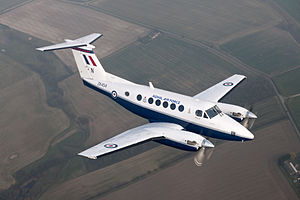Beechcraft Super King Air 200
| Super King Air | |
|---|---|
 |
|
| Role | Civil utility aircraft |
| Manufacturer | Beechcraft |
| First flight | October 27, 1972 |
| Introduction | 1972 (Military) February 1974 (Civil) |
| Status | Active service |
| Primary users |
United States Air Force United States Army Royal Flying Doctor Service of Australia Royal Australian Air Force |
| Produced | 1972–present |
| Number built | 3,550+ |
| Unit cost |
King Air 250: $5,995,000
King Air 250EP: $6,231,025 King Air 350i: $6,995,000 King Air 350HW: $7,329,055 King Air 350iER: $8,445,625 |
| Developed from | Beechcraft King Air |
| Variants |
Beechcraft C-12 Huron Beechcraft 1900 |
The Beechcraft Super King Air family is part of a line of twin-turboprop aircraft produced by Beechcraft. The King Air line comprises a number of model series that fall into four families: the Model 90 series, Model 100 series (these models comprising the King Air family), Model 200 series and Model 300 series. The latter two models were originally marketed as the "Super King Air" family, but the "Super" was dropped in 1996.
The Super King Air family has been in continuous production since 1974, the longest production run of any civilian turboprop aircraft in its class. It has outlasted all of its previous competitors and as of 2009 the only other aircraft in its class is the Piaggio P.180 Avanti. At the present, the B200GT, B200CGT and the larger B300 and B300C are the production models. Special mission derivative versions of these models are also available for order.
The Beechcraft 1900 regional airliner was derived from the Model B200 King Air.
The Model 200 was originally conceived as the Model 101 in 1969, and was a development of the Model 100 King Air. The Model 200 had essentially the same fuselage as the Model 100, with changes to the rear fuselage to accommodate a new T-tail (in place of the 100's conventional tail with all-moving trimmable horizontal stabilizer) and structural changes to allow higher maximum pressurization. Apart from the T-tail, other changes included Pratt & Whitney Canada PT6A-41 engines rated at 1,015 shp (757 kW) instead of the 805 shp (600 kW) engines of the Model A100 then in production, and a wing of increased span and extra fuel capacity. Overall, the 200 was 3 ft 10 in (1.17 m) longer than the A100, with wingspan 4 ft 3 in (1.29 m) greater, containing 60 US gallons (230 L) more fuel. Maximum Take-Off Weight (MTOW) was increased by 1,000 lb (450 kg). After protracted development including extensive wind tunnel testing of the design (especially of the T-tail which was tunnel-tested for 375 hours), the first prototype flew for the first time on October 27, 1972; a second prototype took to the air on December 15 the same year. Three production aircraft were also built in 1972 and delivered to the U.S. Army; these three were designated Model A100-1s by Beechcraft and were given the military designation RU-21J; the first of some 400 T-tail King Airs to be ordered by the U.S. armed forces. The 200 received civil certification in December 1973 and the first civil delivery took place in February 1974.
...
Wikipedia
